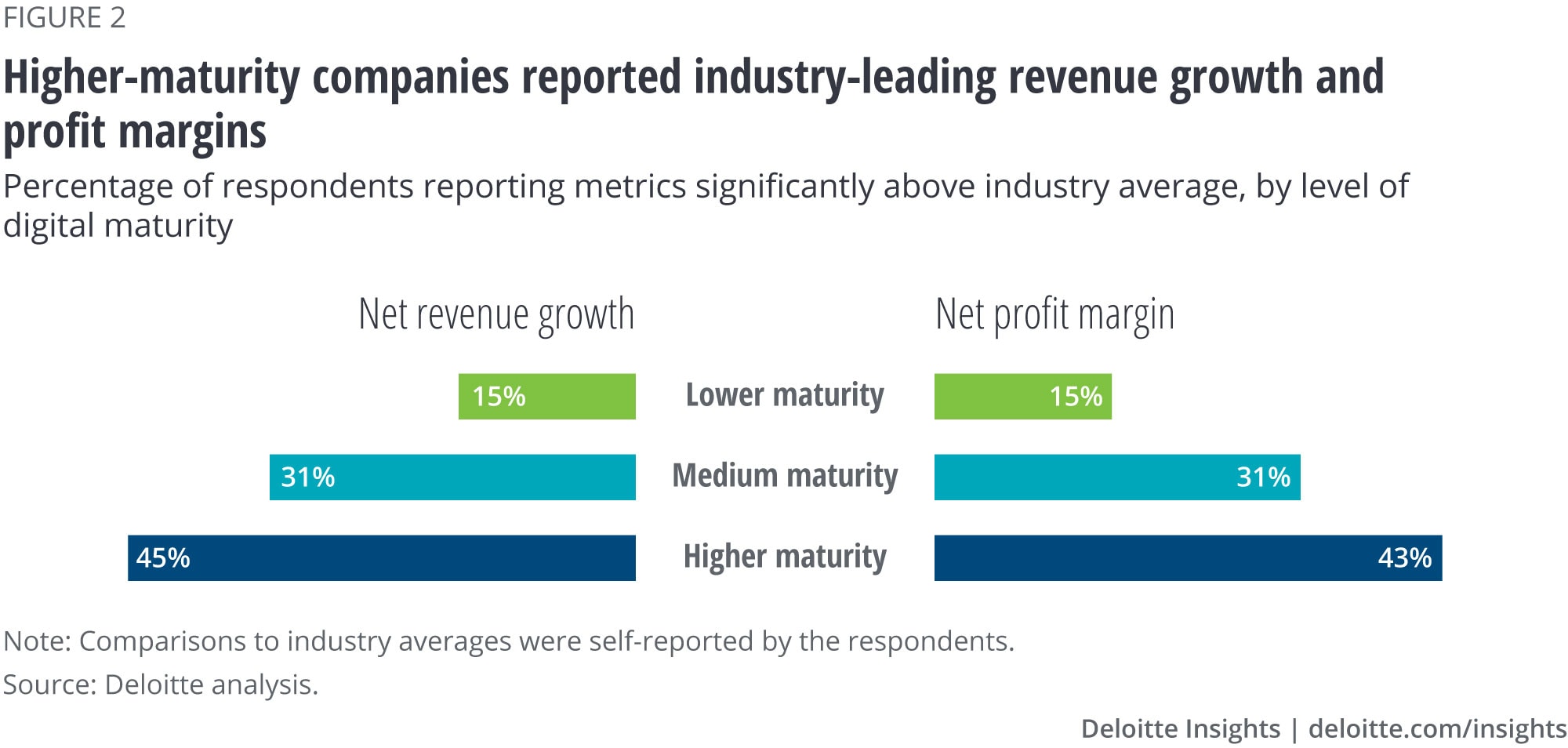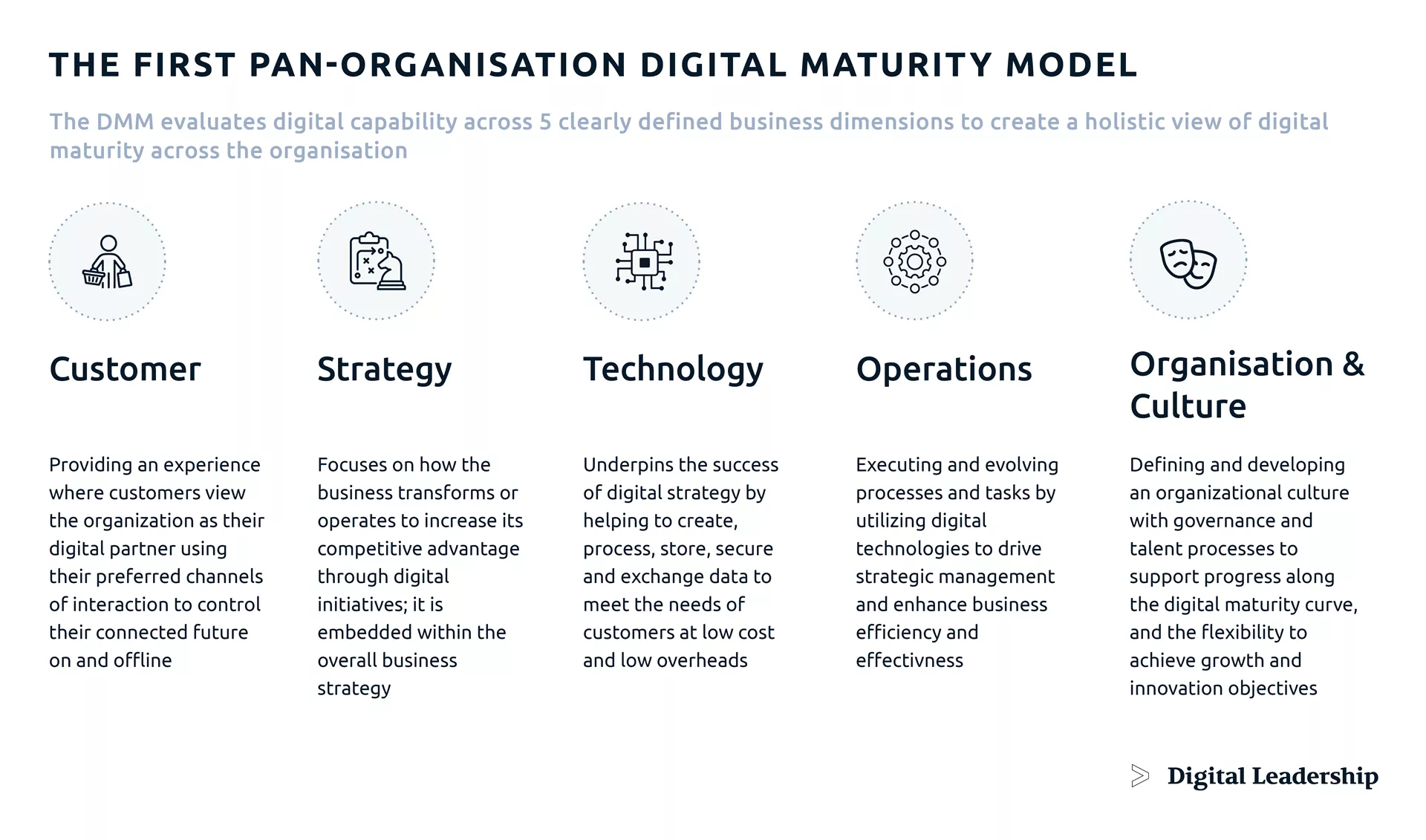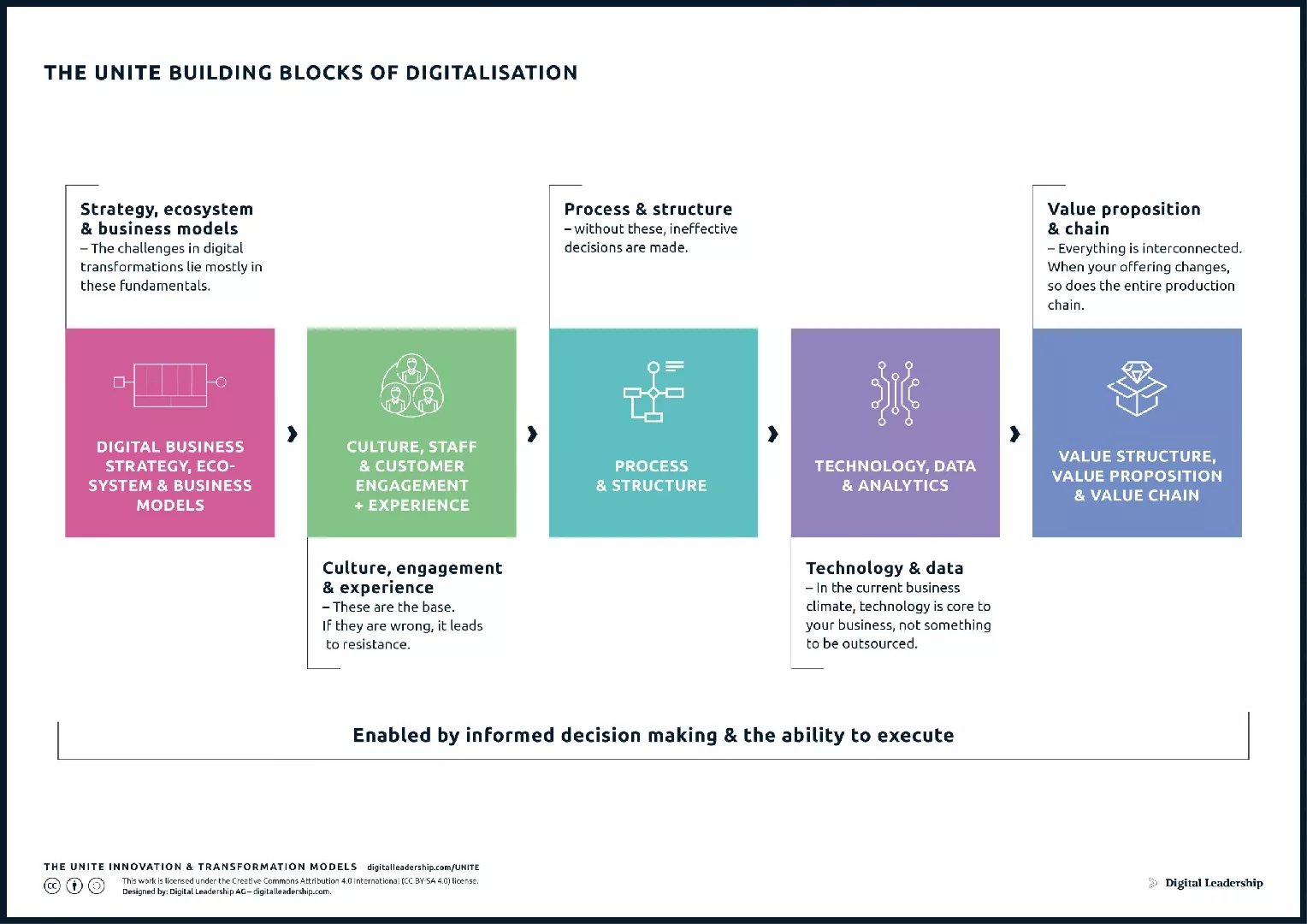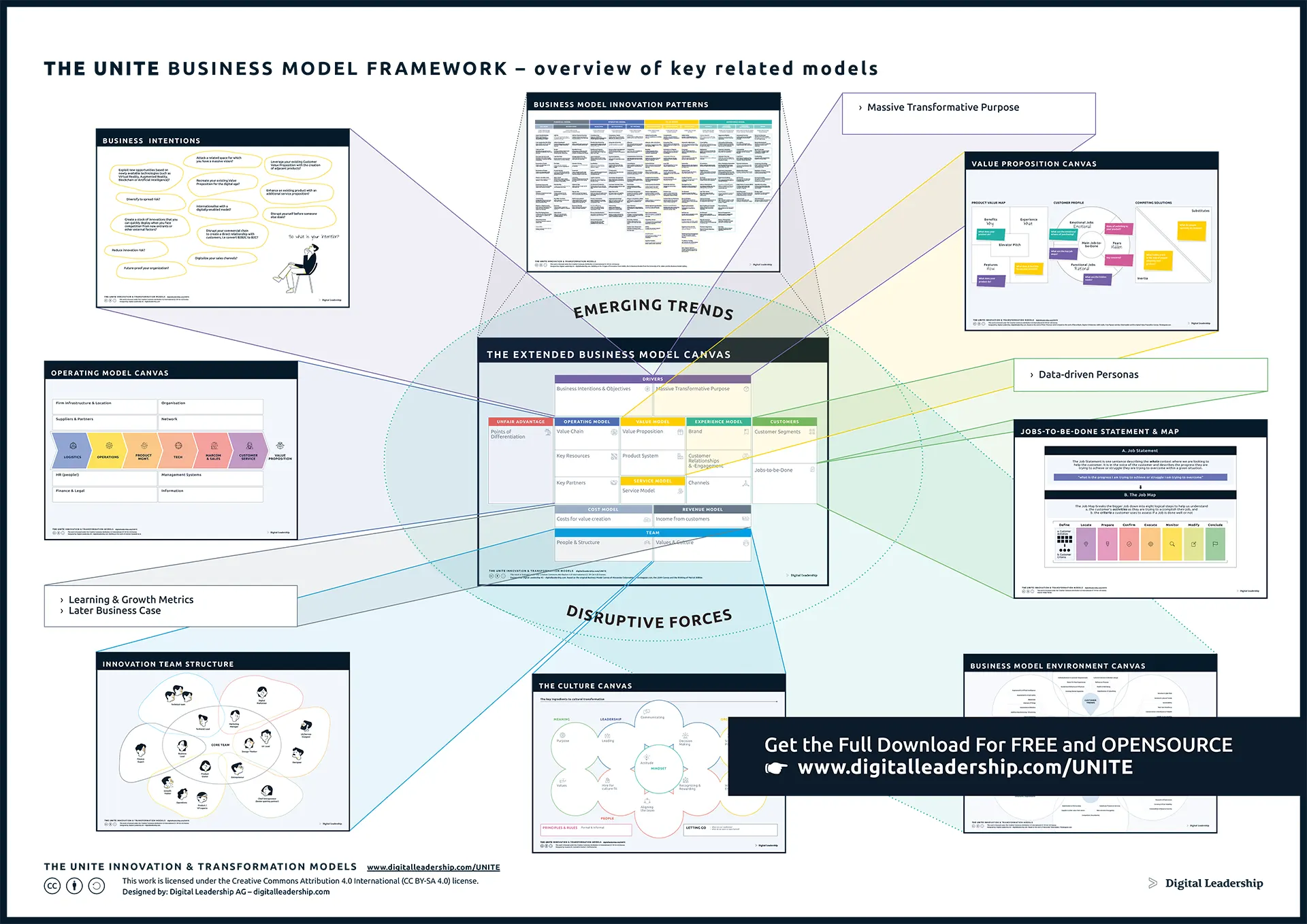What is Digital Maturity, How to Measure, Tools & Models
Published: 01 February, 2022
Digital Strategy

Table of Contents
What is Digital Maturity?
Digital Maturity refers to an organization’s ability to quickly respond to the developments and shifting trends of technology. The focus is on creating value through these new capabilities and consumer interests fast enough to have a competitive advantage over rivals. Digital Maturity requires investment in the tools and human resources that can best leverage new technology.
According to a KPMG survey of manufacturing CEOs, nearly two-thirds say ‘agility is the new currency of business. if we’re too slow, we’ll be bankrupt.’ However, one in three agrees that their organization is struggling to keep pace with technological innovation.
Nearly 80% of companies are in digital transformation, but 90% of those companies face severe success obstacles.
Much more about the digital maturity model, the innovation process, Digital Transformation, and other approaches to innovation strategies you will find in our brand-new FREE book “HOW TO CREATE INNOVATION”. It includes comprehensive approaches with mindsets, structures, and strategies to innovate in less time, with fewer resources and more success. Register for the download now!
Hell Is Full Of Good Intentions
Despite their intention to digitally transform their businesses, 78% of companies attempting digital transformation failed to achieve their objective, while 73% could not provide any business value whatsoever. Why?

Designed by: Digital Leadership AG
The reasons are diverse and complicated, ranging from a lack of top management commitment to fatigue from continuous change to the challenges arising from adopting a technology-first approach. However, the overarching reason for poor digital transformation performance is that organizations lose track of what their customers want from them. Most digital transformation initiatives fail because they do not start with customers.
Companies that stay focused on customers’ expectations, preferences, and buying behavior see their digital transformation projects take off and become sustainable. The bottom-line results are remarkable. McKinsey’s research shows that the best-performing 10% of digitized enterprises earn as much as 80% of their industries’ digital revenues.
The other primary reason for running a fruitless digital transformation program is that business leaders start their digitization journey without knowing where they are on the digital maturity curve.
Before you can achieve digital maturity, you need to get an overview of your capabilities. The UNITE Business Capability Map offers a visual summary to help you leverage your strengths and assets for both innovation initiatives and digital transformations.
Digital Maturity And DX Performance
A recent Deloitte survey reveals the correlation between a company’s digital maturity and its financial performance following a digital transformation project. The study uses ‘seven digital pivots’ to determine an organization’s progress toward digital maturity. The pivots include:
- A flexible and secure infrastructure
- Data mastery
- Digitally savvy, open talent networks
- Ecosystem engagement
- Intelligent workflows
- Unified customer experience and
- Business model adaptability
It was found that more digitally mature organizations were far more likely to significantly exceed their industry average on crucial financial metrics compared to less digitally mature organizations. For example, businesses with higher digital maturity realize three times higher growth in revenues than firms with low maturity.

The findings may seem remarkable, but they are easy to explain. Digital maturity measures how prepared an organization is to understand and adapt consistently to customer demands created by ongoing technological change. The companies with a higher (digital) maturity level do get better business results since they get the benefits from their past investments and their increased digitization. They have superior offerings, processes, marketing, adaptability, vision, and culture.
And they are seeing quite significant results because they are in a better position to foresee and understand customer demands and add digital value faster than organizations with lower digital maturity.
How To Measure Digital Maturity?
Discovery is the first step in the digital transformation journey. It’s at this stage you lay down the foundation of your digital transformation journey. If you know where you stand, it becomes easier to go where you want to go and to find out how long it will take to reach your destination. Here are the questions that the discovery phase will help you answer as you progress on your digital transformation journey and the question of how to measure digital maturity:
- Do we have a clear strategic direction, vision, and objectives?
- Where are we in our digital discovery journey?
- Do we have buy-in across the organization?
- What disruptive forces drive the digital transformation in our organization, e. g. market competition, customer demands, & technology disruption.
- What emerging trends do we see emerging that will impact us as a firm?
- Compared to the market, are we among the leaders, laggards, or mediocre?
- How consistent is our digital experience across different channels?
- How are we going to transform digitally?
- How shall we measure the success of our initiatives?
Related: How to measure Innovation? Innovation Metrics for Companies
Digital Maturity Measuring Tools
Digital maturity is more of a continuum than a rigid scale and should be viewed as a flexible and dynamic concept. Just like physical maturity,
Digital maturity is also a gradual process that takes time to grow across the organization. An organization doesn’t know what it will become once it matures digitally, just like a child doesn’t know what they’ll look like when they grow up. Only a small percentage of children actually achieve their ambitions. So is the case with digital transformation. However, digital maturity doesn’t come naturally like physical maturity.
There are several Digital Maturity models available to help determine the level of digital maturity. Some of them define three, four, or even five stages of digital maturity. Depending upon which Digital Transformation Maturity model you follow, the stages can include higher, medium, and lower, beginner, intermediate, advanced, and expert; or traditional, emerging, engaged, competitive, and maturing.
Fortunately, many tools are now available to help organizations assess their maturity level, identify DX opportunities, and align their digital ambition with a transformation and innovation strategy and roadmap. We’ll be discussing a couple of tools here to give you an idea.
Digital Maturity Model (DMM) By Deloitte

Source: Deloitte Digital Maturity Model
Deloitte and the TM Forum introduced the Digital Maturity Model (DMM) in 2018. The DMM describes digital maturity in terms of digital capability across five clearly defined business dimensions.
| Business Dimension | Goal |
| Customer | To be viewed by customers as their digital partner that helps them control their connected future using their preferred channels. |
| Strategy | How a business operates to increase its competitive advantage through digital initiatives, as embedded in the company’s overall business strategy. |
| Technology | How successfully a business uses digital technologies to meet customer needs while reducing cost and overheads. |
| Operations | Devising and executing digitally-driven processes and activities that increase business efficiency and power strategic management. |
| Organization and Culture | Visualizing and developing a company culture including talent processes and management practices that supports digital transformation and progress along the digital maturity continuum. |
The TM Forum has added ‘Data’ as the sixth dimension, which evaluates an organization’s ability to make ethical and practical use of data on a strategic and operational level to maximize business value. The five or six business dimensions are further divided into 28 sub-dimensions and 179 digital criteria that an organization can measure to determine its maturity level.
The tool determines an organization’s digital maturity based on digital transformation initiatives’ positive business impact. For the purpose of the survey, participants were asked questions along with the seven digital pivots, and their responses were aggregated to define three maturity levels as follows:
Digital Maturity Levels:
- Higher Maturity: Organizations scoring in the top 25%
- Medium Maturity: Organizations in the middle 54%
- Lower Maturity: Organizations in the bottom 21% of digital technologies
BCG’s Digital Acceleration Index (DAI)

The Boston Consulting Group (BCG), in partnership with IDMA Singapore, has developed another framework to help companies conduct an audit of their current digital capabilities. The Digital Acceleration Index (DAI) enables companies to assess and evaluate their digital strengths and weaknesses to determine how digitally mature they are compared to their competitors, digital leaders, and the industry average.
The DAI evaluates a company’s digital maturity across six fundamental building blocks, which are as follows:
| Key Building Blocks | Goal |
| Business strategy is driven by digital | The vision, ambition level, priorities & alignment, and digital roadmap of an organization |
| Digitize the core | The degree of digital maturity along the core value chain from customer offer and go-to-market, to operations, and support functions. |
| New digital growth | Developing new digital products and services, pilots and venture capital, and incubator programs. |
| Changing ways of working | An organization’s digital culture and governance as well as its people improvement policies and training opportunities |
| Data & technology | The management of data – from strategy to governance, from digital platforms to artificial intelligence, and the future-readiness of the world-class technology function, plus Develop Ops, cyber security, and internet of things |
| Integrating ecosystems | Orchestration of digital-related partnerships and how joint value is created from it, e.g., by complementing digital offerings Broadly, through the DAI, companies can better understand their DAI maturity stages |
The six fundamental building blocks have been further subdivided into 36 categories to measure and track a company’s digital maturity. The Index has three versions —Light, Full, and Extended. The Extended versions allow companies to assess their digital transformation maturity level, audit current digital initiatives, conduct competitor analysis, and investment analysis, uncover digital growth opportunities, and take business tech tours.
The DAI database gathers digital maturity data from over 8,000 companies using more than 1,500 data points. The tool enables you to compare your organization’s digital maturity level with competitors, industry leaders, and industry averages to let you find out your relative position in your market.
The DAI maturity stages include:
Digital Starter: The organization has no clear plan for digital transformation, although IT and business functions may collaborate from time to time in an ad hoc manner.
Digital Literate: Leaders recognize the need and value of digital technologies and are ready to invest in digital transformation. A roadmap exists, and projects are in the early stages. However, business units, functions, and regions are still operating in functional silos rather than being part of a coordinated organization-wide effort.
Digital Performer: A robust digital mindset exists, and a clear transformation path is defined. The talent and data platforms required for digitization were set up. Several digital initiatives were successful, and new digital services and businesses were also launched.
Digital Leader: Digital is embedded throughout the entire organization and is driving innovation, R&D, value delivery, digital technologies adoption, strategy development, and day-to-day operations. The company outperforms its peers in key digital metrics and sees digital as an essential driver of business.
Related: The UNITE Business Model Innovation Patterns
Digital Maturity Model Limitations
Digital Maturity Models can give you a clear feeling of where you stand today as an organization compared to other players in the marketplace across a number of dimensions. As such, they can therefore give you an understanding of how far you are compared to the competition. The revelation may be useful to help build a business case and argumentation toward top-level management.
However, Digital Transformation Maturity Models do have their limits which have to be understood:
1. It does not tell you where to invest.
Very simply, a Digital Maturity Model does not tell you where to invest or where to take action. Your maturity may be low in an area, but is that a good sign or a bad sign? The decision to temporarily ignore that particular area could have been a conscious one. The lower maturity in that area may be part of your business strategy since that area has less relevance in your business setting. Or your maturity might be high in a specific area. Should you then continue to invest as to create a source of differentiation or is that a waste? Those questions cannot be answered through Digital Maturity Models. They tend to create confusion where they should be creating clarity.
2. They cannot replace strategy.
Digital Maturity can therefore not replace strategy. Strategy is about making choices, which may be tough sometimes. Where do you want to strategically invest your resources? What are you differentiating with? What are the unique core capabilities that you may want to leverage in totally new ways?
A business has always and by definition limited resources. Strategy is about understanding where to invest and which resources to leverage to get the most results. Digital Maturity Models have therefore no real value in a strategic context. But what could they then be useful for?
While the general shift of focus from Digital Transformation to Digital Maturity makes sense, the comparison against other firms has limited value. You have to measure progress against your strategy, not against a sample of other players within the same industry.
3. Increasing maturity does not necessarily improve business value.
What the makers of Digital Maturity Models like to tell us is that there is increased value with increased maturity. This is however simply wrong. The value delivered does not necessarily increase with increased maturity. Let’s take three examples:
- If you increase maturity in an area that is irrelevant or less relevant in your business, no value is created.
- If you increase maturity in non-core areas – and by far most of the activities a business pursues are “non-core” – no or limited value is created.
- The classical maturity ladder is (1) initial – (2) repeatable – (3) defined – (4) managed – (5) optimized. To get from (1) initial (which is undefined) to level (2) repeatable or (3) defined, you have to undertake an awful lot of documentation. This documentation creates in many cases very limited value at high costs.
These three examples demonstrate that business results can partially get worse with increased maturity – not better. This is counterintuitive since the Maturity Model presents this progress as an “improvement”.
Once more, this means that a business leader will have to make careful choices of whether or not to conduct a Digital Maturity Analysis and how to interpret it. The ice can be quite thin.
4. Comparing against the competition is like driving with a back mirror.
Last but not least, digital maturity compares a firm against its competition. This is like driving with the back mirror. You get your orientation from what is behind you – not what is laying ahead. This is dangerous. Do you believe the industry leader is strategizing based on digital maturity? Do you believe Amazon (as an example) is conducting a digital maturity analysis? In short, the answer is no. Digital Maturity Models tend to tell you where you need to catch up (which is a poor strategy to start with). But they never tell you, where you should truly be going to win the market.

Designed by: Digital Leadership AG
Summary
While Digital Maturity Models can add value to your understanding of relative strength, it cannot tell you where you should be going. Digital Maturity, therefore, represents a tool of competitive monitoring but has limited use as a tool in strategy and business performance optimization. While the general finding of Deloitte is correct to state that increased digital maturity leads to increased results, it is wrong to argue, to therefore follow the competition by increasing the maturity in ‘n’ dimensions.
Rather, it takes thorough analysis and true digital innovation and transformation strategy to understand where the levers are, to define a strategic direction and roadmap that will guide a firm into the future.
Before you can achieve digital maturity, you need to get an overview of your capabilities. The UNITE Business Capability Map offers a visual summary to help you think about which strengths and assets to leverage for both innovation initiatives and digital transformations.
Key Takeaways
- Digital transformation starts and ends with the customer experience. Without a persistent customer focus, companies can lose their way through digital transformation and start substituting customer gains with internal metrics.
- As much as 90% of digital transformation initiatives do not achieve their goals. The major reason is that business leaders start their transformation journey without knowing where their companies stand in terms of digital and without knowing where to add value.
- Digital Maturity is a concept that helps organizations to evaluate their existing digital capabilities. More digitally mature organizations can achieve significantly better bottom-line results from digital transformation.
- Tools like Deloitte Digital Maturity Model (DMM) and BCG Digital Acceleration Index (DAI) can help determine the digital maturity level of your organization. As a result, you may better understand where you stand today when compared to the competition. But that confidence may be misplaced and can lead to a lot of confusion if you don’t have a sound digital strategy in place.
- Digital Maturity is not the same as Digital Transformation Strategy. No digital maturity model or tools can tell you where to invest, how to read customer trends, how to create value, and how to allocate resources. You need a strategy to make the tough choices.
If you are interested, this is what we do here at Digital Leadership: we help organizations develop their own digital innovation and transformation strategy and help you make tough but decisive choices.
[optin-monster-inline slug=”ds0jtoevbqvjvqwcryom”]The UNITE Business Model Framework: A Framework for Innovation Success

Designed By: Digital Leadership AG
Questions? Comments? Be our guest!

































 Book How to Create Innovation
Book How to Create Innovation